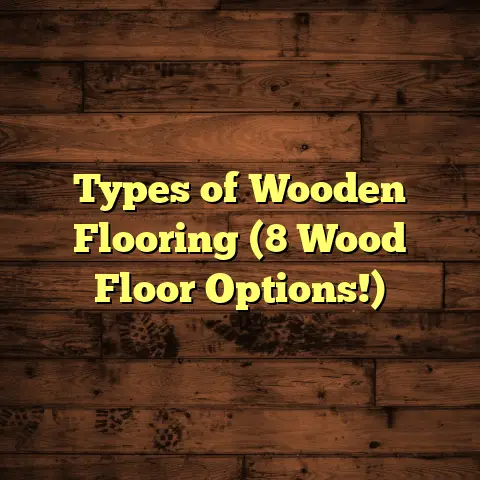Matching Floors & Baseboards? (9 Designer Rules!)
Have you ever walked into a room and felt something was just off?
Maybe you couldn’t quite put your finger on it, but there was a nagging feeling that something wasn’t quite right.
More often than not, it’s the subtle details
that make or break a space.
One of the
biggest culprits?
A mismatch between your
floors and baseboards.
Trust me, I’ve seen it all in my years as a
flooring contractor!
Today, I’m going to
share my expertise and give you the inside
scoop on how to get this detail right.
Understanding the Basics of
Flooring and Baseboards
Let’s start with the fundamentals.
What
are flooring and baseboards, and why do
they matter so much?
Flooring, obviously, is the surface you walk
on.
It’s the foundation of any room, setting
the tone for the entire space.
Baseboards, on the other hand, are the
molding that runs along the bottom of your
walls.
They’re often overlooked, but they
serve a vital purpose, both functionally and
aesthetically.
Functionally, baseboards protect your walls
from scuffs, bumps, and moisture.
They also
cover up the gap between the wall and the
floor, creating a clean, finished look.
But more than that, baseboards are a design
element in their own right.
They add
character, frame the room, and help to tie
everything together.
The key here is cohesiveness.
Think of
your floors and baseboards as partners.
They need to work together to create a
harmonious and visually appealing space.
Designer Rule #1:
Color Coordination
Color is king (or queen!) when it comes to
interior design.
The colors you choose can
dramatically impact the mood and feel of a
room.
That’s why color coordination between
your floors and baseboards is crucial.
Now, that doesn’t necessarily mean they have
to be the exact same color.
In fact, sometimes
a little contrast can be a good thing.
Think about the psychological impact of
color.
Lighter colors tend to make a room feel
more open and airy, while darker colors can
create a sense of warmth and intimacy.
Here are a few color palettes that I’ve found work well:
Light Floors, White Baseboards: This is a classic combination that works in almost any space.
It’s clean, bright, and timeless.Dark Floors, Dark Baseboards: This creates a dramatic and sophisticated look.
It’s perfect for creating a cozy and inviting atmosphere.Neutral Floors, Contrasting Baseboards: This is a great way to add a pop of color and visual interest.
For example, you could pair gray floors with navy blue baseboards.
Don’t be afraid to experiment and find a
color palette that reflects your personal
style!
But always keep in mind the overall
mood you’re trying to create.
Designer Rule #2:
Material Matters
Wood, laminate, vinyl, tile… the options for
flooring and baseboards are endless!
And the
material you choose can have a huge impact on
the overall look and feel of your space.
For example, hardwood flooring is a classic
choice that adds warmth and character to any
room.
It’s durable, long-lasting, and can be
refinished multiple times.
Laminate flooring, on the other hand, is a
more affordable option that mimics the look
of wood or tile.
It’s easy to clean and
maintain, making it a great choice for
high-traffic areas.
Vinyl flooring is another popular choice,
especially for bathrooms and kitchens.
It’s
waterproof, stain-resistant, and comes in a
wide variety of styles and colors.
When it comes to baseboards, wood is the most
common material.
It can be painted or stained
to match your floors or other trim in the room.
But you can also find baseboards made of
other materials, such as MDF (medium-density
fiberboard) or PVC (polyvinyl chloride).
MDF
is a cost-effective option that’s easy to
paint, while PVC is waterproof and ideal for
bathrooms.
The key is to choose materials that complement
each other and suit the overall design of your
space.
For example, you wouldn’t want to pair
rustic hardwood floors with sleek, modern
metal baseboards.
Designer Rule #3:
Height and Proportion
Did you know that the height of your baseboards
can actually affect the perceived size of a
room?
It’s true!
Taller baseboards can make a room feel more grand and formal, while shorter baseboards can create a more casual and relaxed atmosphere.
As a general rule of thumb, the taller your
ceilings, the taller your baseboards should
be.
In a room with standard 8-foot ceilings,
4- to 6-inch baseboards are usually a good fit.
But in a room with 10-foot ceilings or higher, you might want to consider 8-inch or even taller baseboards.
The goal is to achieve visual balance.
You
don’t want your baseboards to look too small
or too large in relation to the size of the
room.
Proportion is key!
And don’t be afraid to
experiment and see what looks best in your
space.
Designer Rule #4:
Style Consistency
Are you going for a modern, traditional, or
eclectic look?
The design style of your space
should influence your choice of flooring and
baseboards.
In a modern space, you might opt for sleek, minimalist flooring and baseboards with clean lines and a neutral color palette.
In a traditional space, you might choose classic hardwood floors and ornate baseboards with intricate detailing.
And in an eclectic space, you can mix and match different styles and materials to create a unique and personalized look.
The key is to maintain style consistency
across both elements.
You don’t want your
floors and baseboards to clash with each
other or with the overall design of the room.
For example, if you have a modern living room with concrete floors and stainless steel accents, you wouldn’t want to install traditional wood baseboards with a Victorian-era design.
Designer Rule #5:
Texture Play
Texture is another important element to
consider when choosing flooring and
baseboards.
It can add depth, dimension, and
visual interest to a room.
Think about the different textures you can
incorporate.
For example, you might choose
flooring with a rough, rustic texture and
baseboards with a smooth, polished finish.
Or you might choose flooring with a subtle, natural texture and baseboards with a more pronounced, decorative texture.
The key is to create a balance between
different textures.
You don’t want too much
texture, which can make a room feel busy and
overwhelming.
But you also don’t want too
little texture, which can make a room feel
flat and lifeless.
Here are a few examples of how you can play with texture:
-
Smooth Floors, Textured Baseboards: This is a great way to add a touch of elegance and sophistication to a room.
-
Textured Floors, Smooth Baseboards: This can create a more casual and relaxed atmosphere.
Mixing Textures: Don’t be afraid to mix different textures to create a unique and personalized look.
Just be sure to do it in a way that feels balanced and harmonious.
Designer Rule #6:
Finish and Sheen
Matte, glossy, satin… the finish and sheen of your floors and baseboards can have a big impact on the overall look of a room.
A matte finish is non-reflective and can
create a more casual and understated look.
It’s a great choice for high-traffic areas
because it doesn’t show scratches and
scuffs as easily.
A glossy finish is highly reflective and can
make a room feel more bright and spacious.
It’s a good choice for formal spaces, but it
can also show dirt and scratches more easily.
A satin finish is somewhere in between matte
and glossy.
It has a slight sheen that adds
a touch of elegance without being too
reflective.
When choosing a finish, consider the overall
style of the room and the amount of light it
receives.
A glossy finish can brighten up a
dark room, while a matte finish can tone down
a bright room.
The key is to create harmony between the
finish of your floors and baseboards.
You
don’t want one to be too shiny and the other
to be too dull.
Designer Rule #7:
Transitioning Between Spaces
In open-concept spaces, you’ll often have
different types of flooring and baseboards
in different areas.
The key is to create
smooth and seamless transitions between
these spaces.
One way to do this is to use thresholds.
A
threshold is a strip of material that covers
the gap between two different types of
flooring.
Thresholds can be made of wood, metal, or other materials, and they come in a variety of styles and colors.
Another way to create smooth transitions is
to use color changes.
For example, you might
paint your baseboards a different color in
each room to create a subtle visual
separation.
The goal is to create a sense of flow and
continuity between the different spaces.
You
don’t want the transitions to feel abrupt or
jarring.
Designer Rule #8:
Practical Considerations
Let’s be honest, aesthetics aren’t the only
thing that matters.
You also need to think
about practical considerations like cleaning,
maintenance, and longevity.
Some flooring and baseboard combinations are
easier to clean and maintain than others.
For
example, vinyl flooring is very easy to clean
and is a great choice for high-traffic areas.
Hardwood flooring, on the other hand, requires
more care and maintenance.
You’ll need to
sweep or vacuum it regularly and occasionally
mop it with a wood-friendly cleaner.
When choosing flooring and baseboards, think about your lifestyle and how much time and effort you’re willing to put into maintenance.
You should also consider the longevity of
different materials.
Some materials are more
durable and long-lasting than others.
For example, hardwood flooring can last for decades if properly maintained, while laminate flooring may need to be replaced after 10-15 years.
Designer Rule #9:
Personalization and Trends
Finally, don’t forget to consider your own
personal style and the latest design trends!
After all, your home should be a reflection
of who you are.
But be careful not to get too caught up in
trends.
Some trends come and go quickly, and
you don’t want to invest in something that
will look dated in a few years.
The key is to find a balance between
personal taste and timeless design principles.
Choose flooring and baseboards that you love
and that will stand the test of time.
Don’t be afraid to experiment and try new things, but always keep in mind the overall harmony and cohesiveness of your space.
Conclusion:
So, there you have it – my nine designer rules for matching floors and baseboards!
- Color Coordination: Make sure your colors complement each other.
- Material Matters: Choose materials that suit the style and function of your space.
- Height and Proportion: Consider the height of your ceilings and the size of the room.
- Style Consistency: Maintain a consistent design style throughout the space.
- Texture Play: Add depth and dimension with different textures.
- Finish and Sheen: Choose a finish that suits the style and lighting of the room.
- Transitioning Between Spaces: Create smooth transitions between different areas.
- Practical Considerations: Think about cleaning, maintenance, and longevity.
- Personalization and Trends: Let your personal style shine through!
Matching floors and baseboards is more than
just a matter of aesthetics.
It’s about
creating a space that feels balanced,
harmonious, and welcoming.
It’s about creating a home that truly reflects your personality and style.
So, take these rules to heart, get creative,
and have fun designing the space of your
dreams!
And remember, I’m always here to
help if you need a hand.





